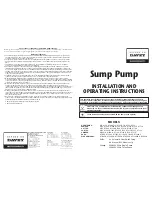
8
855 819 R. 03/12
Samson Corporation • One Samson Way • N.C. 28778 Swannanoa • Phone: 00 1 8286868511 • Fax: 00 1 8286868533
2012_03_06-17:30
Installation
Warning
To avoid personal injury, environmental and equipment next to the pump, make sure that this has been installed in a way that if it leaks or the pump
fails, the spilled fluid is contained by a moat, protective housing , etc.
Air exhaust disposal
• Optional kit is required for remote exhaust.
• Remove the muffler.
• Connect a hose to the exhaust port of the pump and install the muffler at the end of the hose. Use a hose with the same diameter as
the exhaust port. (If the hose is more than 16,4 feet (5 m), consult your dealer or Samoa Industrial, S.A.).
• Have a moat, a protective housing, etc. at the end of the hose.
Warning
The pump exhaust should be directed to a safe place, away
from people, animals and food.
Fluid line connection
• Connect the discharge valve and drain valve to the fluid discharge outlet of the pump (see page 10).
• Connect a valve for maintenance on the fluid inlet.
• Connect a hose to the valve on the suction side of the hole and another hose to the valve discharge port side of the pump.
• Properly connect the suction and discharge hoses to the pump.
Warning
• Use flexible hoses to absorb the vibration of the pump and make a ground connection.
• Make sure that the connections of the pump are not supporting external weight. Take special care that the pump does not support any
part of the weight of the hose and piping.
• Use a properly rated hoses that can support the action of the suction and discharge pressures. Also, make sure that the hoses are
compatible with the product being pumped.
• Use hoses and connectors equal to or greater than the diameter of the connections in the pump. If you use a hose with a smaller diameter
it can decrease the pump performance.
• When pumping a fluid containing solids, verify that the particle size is less than the limitation of the pump. If you exceed the limitation of
particle size indicated in the main specifications, place a filter on the pump to stop the larger particles. Otherwise, the particles can damage
the pump.
• Place a bucket under the relief valve to catch any leakage.
• When testing for a pipeline leak, DO NOT apply pressure to the input and output sides of the pump with compressed air from the outside.
This can cause the diaphragms to rupture.
• For the inspection of the product we use water. To prevent dirty water mixed with the fluid pumped, rinse the inside of the pump before
completing the installation tasks.
• When installing a backup pump or two pumps in parallel, be sure to place a valve on each side (IN and OUT), and change of pump using
the fluid outlet valve. If the valve of the standby pump is open, the discharge pressure pump operating side can go to the backup pump,
causing damage.
EXHAUST
AIR









































